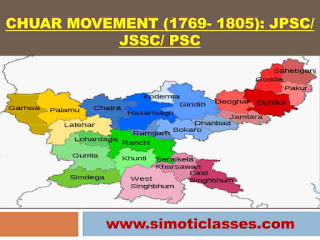Chuar Movement (1769-1805)
Causes:
The British official used to call the Bhumij of Jungle Mahal as Chaur= Duvant/low caste. Hence, their rebellion was called Chaur Rebellion.
The Chuar made a living by clearing forests, hunting animals and birds, and selling the things produced in the forest. Most of them worked as 'Paika= soldiers' in the local zamindars. They were given land instead of salary, which was called 'Paikan land'.
As soon as the British rulers took possession, snatched the ancestral lands of the Chuars and sold them to new landlords, and started settling new subjects with these landlords.
Simultaneously, after removing the paika and bringing it from outside, the police were appointed in their place. Due to this, thousands of paika started stumbling blocks after losing land, house-door, means of livelihood everything. The combined powers of these paikas (sepoys) and peasants ignited the fire of rebellion, which became very difficult for the British rulers to extinguish.
Apart from this, the British rulers had snatched the land from the hands of Zamindars, who were unable to pay the hugely increased revenue. Some of the landlords who had lost their land joined the rebellion. This rebellion was done over famine, increase in rent, auction of land, and other economic issues.
Form of Revolt:
The name of the prominent leaders of the Chuar rebellion are;
- Ragunath Mahto
- Shyam Ganjam Subal Singh
- Jagannath Patar
- Durjan Singh
- Lal Singh
- Mohan Singh.
In 1769, Raghunath Mahto gave the slogan 'Apna Gaon Apna Raj, Faraway Foreign Raj'.
The name of the suppressors of the Chuar rebellion are;
- Lieutenant Nun
- Captain Forbes
- Lieutenant Goodyar.
For nearly 30 years, due to the riots of the Chuars, there was unrest in the entire area.
The Company government understood that without giving some facilities (e.g; the return of their land to paikas, prohibition on the auction of the land of zamindars when revenue is left) to the paikas, farmers, and zamindars, and without restoration of police rights of landlords and Ghatwals, the peace in this area is not possible. Therefore, by a resolution;
- March 6th, 1800, the Zamindari-Ghatwali Police System was restored.
- December 13th, 1800, this arrangement also got the approval of the Company's government.
The law and order situation improved with the appointment of local people as police officers in place of non-tribal inspectors. After the creation of the Jungle Mahal district, relative peace was maintained in the Manbhum area for 25 years (1805-30).
Important facts of Chuar Revolt:
- 1798: In April, the Chuar of Ghatshila, Bindu Mandalkunda, Purugram, etc. of the Jungle Mahal of Birbhum and the Chuars of Midnapore, revolted due to the economic discontent that had arisen against the increase in land revenue by the British.
- In June, Chuar and Paika of Bankura, and Paika of Orissa joined it. British repression did not work in front of the wide nature of the rebellion and the British were forced to return the land and all the facilities snatched from them to the Chuar and Paika chieftains.



















0 comments:
Post a Comment